Evaluation of Radar Precipitation Products and Assessment of the Gauge-Radar Merging Methods in Southeast Texas for Extreme Precipitation Events
Abstract
1. Introduction
2. Data and Methodology
2.1. Study Area
2.2. Radar Rainfall Data
2.3. Rain Gauge Data
2.4. Radar-Gauge Merging Methods for Calibration
2.5. Quantitative Statistics
3. Results and Discussions
3.1. Intercomparison of Orignal Radar Rainfall
3.2. Merged Radar Rainfall
4. Conclusions
- (1)
- Stage IV and MRMS show high consistency for both events with the rain gauge network when RTMA (Figure 5c,f) presents the least consistency, especially the negative NSE value (−0.7721) indicating its accuracy is worse than the means of the gauge records.
- (2)
- Both RK and BRK can increase the quality of the original radar rainfall products shown by statistical metrics (i.e., CC, NSE, and RMSE), especially for low-quality RTMA data. Moreover, the RK is the preferred method since it enhances the results with explainable spatial distribution identified by specialized knowledge.
- (3)
- The BRK method presents better statistical metrics while also indicating over-fitting in certain areas with limited gauge presence for calibration, which means that the spatial distribution (i.e., density) of the rain gauges plays a critical role in the algorithms.
- (4)
- The merged results were found to be sensitive to the original spatial resolution of the radar data for both methods, such that the MMRS with the highest spatial resolution had the best results with both methods and the BRK method worked well on finer resolution than coarse resolution radar data.
Author Contributions
Funding
Data Availability Statement
Acknowledgments
Conflicts of Interest
References
- Salvadore, E.; Bronders, J.; Batelaan, O. Hydrological Modelling of Urbanized Catchments: A Review and Future Directions. J. Hydrol. 2015, 529, 62–81. [Google Scholar] [CrossRef]
- Westra, S.; Fowler, H.J.; Evans, J.P.; Alexander, L.V.; Berg, P.; Johnson, F.; Kendon, E.J.; Lenderink, G.; Roberts, N.M. Future Changes to the Intensity and Frequency of Short-Duration Extreme Rainfall: Future intensity of sub-daily rainfall. Rev. Geophys. 2014, 52, 522–555. [Google Scholar] [CrossRef]
- Molnar, P.; Fatichi, S.; Gaál, L.; Szolgay, J.; Burlando, P. Storm Type Effects on Super Clausius–Clapeyron Scaling of Intense Rainstorm Properties with Air Temperature. Hydrol. Earth Syst. Sci. 2015, 19, 1753–1766. [Google Scholar] [CrossRef]
- Li, D.; Fang, Z.N.; Bedient, P.B. Flood Early Warning Systems under Changing Climate and Extreme Events. In Climate Change and Extreme Events; Elsevier: Amsterdam, The Netherlands, 2021; pp. 83–103. ISBN 978-0-12-822700-8. [Google Scholar]
- Park, N.-W. Spatial Downscaling of TRMM Precipitation Using Geostatistics and Fine Scale Environmental Variables. Adv. Meteorol. 2013, 2013, 237126. [Google Scholar] [CrossRef]
- Goovaerts, P. Geostatistical Approaches for Incorporating Elevation into the Spatial Interpolation of Rainfall. J. Hydrol. 2000, 228, 113–129. [Google Scholar] [CrossRef]
- He, X.; Refsgaard, J.C.; Sonnenborg, T.O.; Vejen, F.; Jensen, K.H. Statistical Analysis of the Impact of Radar Rainfall Uncertainties on Water Resources Modeling: Radar Rainfall Uncertainties on Hydrological Modeling. Water Resour. Res. 2011, 47, W09526. [Google Scholar] [CrossRef]
- Chang, W.-Y.; Vivekanandan, J.; Ikeda, K.; Lin, P.-L. Quantitative Precipitation Estimation of the Epic 2013 Colorado Flood Event: Polarization Radar-Based Variational Scheme. J. Appl. Meteorol. Climatol. 2016, 55, 1477–1495. [Google Scholar] [CrossRef]
- Vieux, B.; Bedient, P. Assessing Urban Hydrologic Prediction Accuracy through Event Reconstruction. J. Hydrol. 2004, 299, 217–236. [Google Scholar] [CrossRef]
- Past Code Updates—MRMS QPE. Available online: https://inside.nssl.noaa.gov/mrms/past-code-updates/ (accessed on 26 August 2022).
- Goudenhoofdt, E.; Delobbe, L. Statistical Characteristics of Convective Storms in Belgium Derived from Volumetric Weather Radar Observations. J. Appl. Meteorol. Climatol. 2013, 52, 918–934. [Google Scholar] [CrossRef]
- Villarini, G.; Krajewski, W.F. Review of the Different Sources of Uncertainty in Single Polarization Radar-Based Estimates of Rainfall. Surv. Geophys. 2010, 31, 107–129. [Google Scholar] [CrossRef]
- Einfalt, T.; Jessen, M.; Mehlig, B. Comparison of Radar and Raingauge Measurements during Heavy Rainfall. Water Sci. Technol. 2005, 51, 195–201. [Google Scholar] [CrossRef] [PubMed]
- Li, Z.; Chen, M.; Gao, S.; Hong, Z.; Tang, G.; Wen, Y.; Gourley, J.J.; Hong, Y. Cross-Examination of Similarity, Difference and Deficiency of Gauge, Radar and Satellite Precipitation Measuring Uncertainties for Extreme Events Using Conventional Metrics and Multiplicative Triple Collocation. Remote Sens. 2020, 12, 1258. [Google Scholar] [CrossRef]
- Molini, A.; Lanza, L.G.; La Barbera, P. The Impact of Tipping-Bucket Raingauge Measurement Errors on Design Rainfall for Urban-Scale Applications. Hydrol. Process. 2005, 19, 1073–1088. [Google Scholar] [CrossRef]
- Dai, Q.; Yang, Q.; Zhang, J.; Zhang, S. Impact of Gauge Representative Error on a Radar Rainfall Uncertainty Model. J. Appl. Meteorol. Climatol. 2018, 57, 2769–2787. [Google Scholar] [CrossRef]
- Bárdossy, A.; Das, T. Influence of Rainfall Observation Network on Model Calibration and Application. Hydrol. Earth Syst. Sci. 2008, 12, 77–89. [Google Scholar] [CrossRef]
- Arsenault, R.; Brissette, F. Determining the Optimal Spatial Distribution of Weather Station Networks for Hydrological Modeling Purposes Using RCM Datasets: An Experimental Approach. J. Hydrometeorol. 2014, 15, 517–526. [Google Scholar] [CrossRef]
- Wang, L.-P.; Ochoa-Rodríguez, S.; Simões, N.E.; Onof, C.; Maksimović, Č. Radar–Raingauge Data Combination Techniques: A Revision and Analysis of Their Suitability for Urban Hydrology. Water Sci. Technol. 2013, 68, 737–747. [Google Scholar] [CrossRef]
- Krajewski, W.F. Cokriging Radar-Rainfall and Rain Gage Data. In 1987, Rainfall Fields: Estimation, Analysis, and Prediction; Collected Reprint Series; American Geophysical Union: Washington, DC, USA, 2013; pp. 9571–9580. ISBN 978-1-118-78207-1. [Google Scholar]
- Steiner, M.; Smith, J.A.; Burges, S.J.; Alonso, C.V.; Darden, R.W. Effect of Bias Adjustment and Rain Gauge Data Quality Control on Radar Rainfall Estimation. Water Resour. Res. 1999, 35, 2487–2503. [Google Scholar] [CrossRef]
- Erdin, R. Geostatistical Methods for Hourly Radar-Gauge Combination: An Explorative, Systematic Application at MeteoSwiss; MeteoSchweiz: Genève, Switzerland, 2013. [Google Scholar]
- Jewell, S.A.; Gaussiat, N. An Assessment of Kriging-based Rain-gauge–Radar Merging Techniques. Q. J. R. Meteorol. Soc. 2015, 141, 2300–2313. [Google Scholar] [CrossRef]
- Benoit, L. Radar and Rain Gauge Data Fusion Based on Disaggregation of Radar Imagery. Water Res. 2021, 57, e2020WR027899. [Google Scholar] [CrossRef]
- Decloedt, C.; Willems, P. Methods and Experiences in Radar Based Fine Scale Rainfall Estimation. 2013. Available online: http://www.raingain.eu/sites/default/files/raingain_wp2-reviewdoc.pdf (accessed on 21 August 2021).
- Ochoa-Rodriguez, S.; Wang, L.-P.; Willems, P.; Onof, C. A Review of Radar-Rain Gauge Data Merging Methods and Their Potential for Urban Hydrological Applications. Water Resour. Res. 2019, 55, 6356–6391. [Google Scholar] [CrossRef]
- Lo Conti, F.; Francipane, A.; Pumo, D.; Noto, L.V. Exploring Single Polarization X-Band Weather Radar Potentials for Local Meteorological and Hydrological Applications. J. Hydrol. 2015, 531, 508–522. [Google Scholar] [CrossRef]
- McKee, J.L.; Binns, A.D. A Review of Gauge–Radar Merging Methods for Quantitative Precipitation Estimation in Hydrology. Can. Water Resour. J./Rev. Can. Des Ressour. Hydr. 2016, 41, 186–203. [Google Scholar] [CrossRef]
- Anagnostou, M.; Nikolopoulos, E.; Kalogiros, J.; Anagnostou, E.; Marra, F.; Mair, E.; Bertoldi, G.; Tappeiner, U.; Borga, M. Advancing Precipitation Estimation and Streamflow Simulations in Complex Terrain with X-Band Dual-Polarization Radar Observations. Remote Sens. 2018, 10, 1258. [Google Scholar] [CrossRef]
- Reichert, P.; Mieleitner, J. Analyzing Input and Structural Uncertainty of Nonlinear Dynamic Models with Stochastic, Time-Dependent Parameters: Analyzing Input and Structural Uncertainty. Water Resour. Res. 2009, 45, W10402. [Google Scholar] [CrossRef]
- Cole, S.J.; Moore, R.J. Hydrological Modelling Using Raingauge- and Radar-Based Estimators of Areal Rainfall. J. Hydrol. 2008, 358, 159–181. [Google Scholar] [CrossRef]
- Nanding, N.; Rico-Ramirez, M.A.; Han, D. Comparison of Different Radar-Raingauge Rainfall Merging Techniques. J. Hydroinform. 2015, 17, 422–445. [Google Scholar] [CrossRef]
- Rabiei, E.; Haberlandt, U. Applying Bias Correction for Merging Rain Gauge and Radar Data. J. Hydrol. 2015, 522, 544–557. [Google Scholar] [CrossRef]
- Seo, D.-J.; Breidenbach, J.P. Real-Time Correction of Spatially Nonuniform Bias in Radar Rainfall Data Using Rain Gauge Measurements. J. Hydrometeor. 2002, 3, 93–111. [Google Scholar] [CrossRef]
- Sideris, I.V.; Gabella, M.; Erdin, R.; Germann, U. Real-Time Radar-Rain-Gauge Merging Using Spatio-Temporal Co-Kriging with External Drift in the Alpine Terrain of Switzerland: Real-Time Radar-Rain-Gauge Merging. Q. J. R. Meteorol. Soc. 2014, 140, 1097–1111. [Google Scholar] [CrossRef]
- Thorndahl, S.; Einfalt, T.; Willems, P.; Nielsen, J.E.; ten Veldhuis, M.-C.; Arnbjerg-Nielsen, K.; Rasmussen, M.R.; Molnar, P. Weather Radar Rainfall Data in Urban Hydrology. Hydrol. Earth Syst. Sci. 2017, 21, 1359–1380. [Google Scholar] [CrossRef]
- Kumar, A.; Binns, A.D.; Gupta, S.K.; Singh, V.P.; McKee, J.L. Analysing the Performance of Various Radar-Rain Gauge Merging Methods for Modelling the Hydrologic Response of Upper Thames River Basin, Canada. In Proceedings of the World Environmental and Water Resources Congress, West Palm Beach, FL, USA, 22–26 May 2016; pp. 359–371. [Google Scholar]
- Ochoa-Rodriguez, S.; Wang, L.; Bailey, A.; Schellart, A.; Willems, P.; Onof, C. Evaluation of Radar-Rain Gauge Merging Methods for Urban Hydrological Applications: Relative Performance and Impact of Gauge Density. In Proceedings of the UrbanRain15 Proceedings “Rainfall in Urban and Natural Systems”, Pontresina, Switzerland, 1–5 December 2015. [Google Scholar]
- Teng, H.; Ma, Z.; Chappell, A.; Shi, Z.; Liang, Z.; Yu, W. Improving Rainfall Erosivity Estimates Using Merged TRMM and Gauge Data. Remote Sens. 2017, 9, 1134. [Google Scholar] [CrossRef]
- Qiu, Q.; Liu, J.; Tian, J.; Jiao, Y.; Li, C.; Wang, W.; Yu, F. Evaluation of the Radar QPE and Rain Gauge Data Merging Methods in Northern China. Remote Sens. 2020, 12, 363. [Google Scholar] [CrossRef]
- Zhang, J.; Xu, J.; Dai, X.; Ruan, H.; Liu, X.; Jing, W. Multi-Source Precipitation Data Merging for Heavy Rainfall Events Based on Cokriging and Machine Learning Methods. Remote Sens. 2022, 14, 1750. [Google Scholar] [CrossRef]
- Thorndahl, S.; Nielsen, J.E.; Rasmussen, M.R. Bias Adjustment and Advection Interpolation of Long-Term High Resolution Radar Rainfall Series. J. Hydrol. 2014, 508, 214–226. [Google Scholar] [CrossRef]
- Villarini, G.; Smith, J.A.; Lynn Baeck, M.; Sturdevant-Rees, P.; Krajewski, W.F. Radar Analyses of Extreme Rainfall and Flooding in Urban Drainage Basins. J. Hydrol. 2010, 381, 266–286. [Google Scholar] [CrossRef]
- Sakib, S.; Ghebreyesus, D.; Sharif, H.O. Performance Evaluation of IMERG GPM Products during Tropical Storm Imelda. Atmosphere 2021, 12, 687. [Google Scholar] [CrossRef]
- Nielsen-Gammon, J.W.; Zhang, F.; Odins, A.M.; Myoung, B. Extreme Rainfall in Texas: Patterns and Predictability. Phys. Geogr. 2005, 26, 340–364. [Google Scholar] [CrossRef]
- Du, J. NCEP/EMC 4KM Gridded Data (GRIB) Stage IV Data; Version 1.0 2011; UCAR/NCAR—Earth Observing Laboratory. Available online: https://data.eol.ucar.edu/dataset/21.093 (accessed on 26 November 2021).
- Zhang, J.; Howard, K.; Langston, C.; Kaney, B.; Qi, Y.; Tang, L.; Grams, H.; Wang, Y.; Cocks, S.; Martinaitis, S.; et al. Multi-Radar Multi-Sensor (MRMS) Quantitative Precipitation Estimation: Initial Operating Capabilities. Bull. Am. Meteorol. Soc. 2016, 97, 621–638. [Google Scholar] [CrossRef]
- De Pondeca, M.S.F.V.; Manikin, G.S.; DiMego, G.; Benjamin, S.G.; Parrish, D.F.; Purser, R.J.; Wu, W.-S.; Horel, J.D.; Myrick, D.T.; Lin, Y.; et al. The Real-Time Mesoscale Analysis at NOAA’s National Centers for Environmental Prediction: Current Status and Development. Weather Forecast. 2011, 26, 593–612. [Google Scholar] [CrossRef]
- Lin, Y.; Mitchell, K.E. The NCEP Stage II/IV Hourly Precipitation Analyses: Development and Applications. In Proceedings of the 19th Conference Hydrology, American Meteorological Society, San Diego, CA, USA, 9–13 January 2005; Volume 10. [Google Scholar]
- Cocks, S.B.; Tang, L.; Zhang, P.; Ryzhkov, A.; Kaney, B.; Elmore, K.L.; Wang, Y.; Zhang, J.; Howard, K. A Prototype Quantitative Precipitation Estimation Algorithm for Operational S-Band Polarimetric Radar Utilizing Specific Attenuation and Specific Differential Phase. Part II: Performance Verification and Case Study Analysis. J. Hydrometeorol. 2019, 20, 999–1014. [Google Scholar] [CrossRef]
- Martinaitis, S.M.; Osborne, A.P.; Simpson, M.J.; Zhang, J.; Howard, K.W.; Cocks, S.B.; Arthur, A.; Langston, C.; Kaney, B.T. A Physically Based Multisensor Quantitative Precipitation Estimation Approach for Gap-Filling Radar Coverage. J. Hydrometeorol. 2020, 21, 1485–1511. [Google Scholar] [CrossRef]
- Wu, W.-S.; Purser, R.J.; Parrish, D.F. Three-Dimensional Variational Analysis with Spatially Inhomogeneous Covariances. Mon. Wea. Rev. 2002, 130, 2905–2916. [Google Scholar] [CrossRef]
- Morris, M.T.; Carley, J.R.; Colón, E.; Gibbs, A.; De Pondeca, M.S.F.V.; Levine, S. A Quality Assessment of the Real-Time Mesoscale Analysis (RTMA) for Aviation. Weather. Forecast. 2020, 35, 977–996. [Google Scholar] [CrossRef]
- Gao, S.; Zhang, J.; Li, D.; Jiang, H.; Fang, Z.N. Evaluation of Multiradar Multisensor and Stage IV Quantitative Precipitation Estimates during Hurricane Harvey. Nat. Hazards Rev. 2021, 22, 04020057. [Google Scholar] [CrossRef]
- Hjelmstad, A.; Shrestha, A.; Garcia, M.; Mascaro, G. Propagation of Radar Rainfall Uncertainties into Urban Pluvial Flood Modeling during the North American Monsoon. Hydrol. Sci. J. 2021, 66, 2232–2248. [Google Scholar] [CrossRef]
- Ali, A.; Supriatna, S.; Sa’adah, U. Radar-Based Stochastic Precipitation Nowcasting Using the Short-Term Ensemble Prediction System (Steps) (Case Study: Pangkalan Bun Weather Radar). IJReSES 2021, 18, 91. [Google Scholar] [CrossRef]
- Wackernagel, H. Multivariate Geostatistics: An Introduction with Applications; Springer Science & Business Media: Berlin/Heidelberg, Germany, 2003. [Google Scholar]
- Ali, G.; Sajjad, M.; Kanwal, S.; Xiao, T.; Khalid, S.; Shoaib, F.; Gul, H.N. Spatial–Temporal Characterization of Rainfall in Pakistan during the Past Half-Century (1961–2020). Sci. Rep. 2021, 11, 6935. [Google Scholar] [CrossRef]
- Hengl, T.; Heuvelink, G.B.M.; Rossiter, D.G. About Regression-Kriging: From Equations to Case Studies. Comput. Geosci. 2007, 33, 1301–1315. [Google Scholar] [CrossRef]
- Todini, E. A Bayesian Technique for Conditioning Radar Precipitation Estimates to Rain-Gauge Measurements. Hydrol. Earth Syst. Sci. 2001, 5, 187–199. [Google Scholar] [CrossRef]
- Krivoruchko, K. Empirical Bayesian Kriging. ArcUser Fall 2012, 6, 1145. [Google Scholar]
- Gribov, A.; Krivoruchko, K. Empirical Bayesian Kriging Implementation and Usage. Sci. Total Environ. 2020, 722, 137290. [Google Scholar] [CrossRef] [PubMed]
- Habibi, H.; Awal, R.; Fares, A.; Temimi, M. Performance of Multi-Radar Multi-Sensor (MRMS) Product in Monitoring Precipitation under Extreme Events in Harris County, Texas. J. Hydrol. 2021, 598, 126385. [Google Scholar] [CrossRef]
- Neter, J.; Kutner, M.H.; Nachtsheim, C.J.; Wasserman, W. Applied Linear Statistical Models; Irwin: Chicago, IL, USA, 1996; Volume 4. [Google Scholar]
- Webster, R.; Oliver, M.A. Geostatistics for Environmental Scientists; John Wiley & Sons: Hoboken, NJ, USA, 2007. [Google Scholar]
- Rico-Ramirez, M.A.; Liguori, S.; Schellart, A.N.A. Quantifying Radar-Rainfall Uncertainties in Urban Drainage Flow Modelling. J. Hydrol. 2015, 528, 17–28. [Google Scholar] [CrossRef]
- Fang, Z.; Safiolea, E.; Bedient, P.B. Enhanced Flood Alert and Control Systems for Houston. In Coastal Hydrology and Processes: Proceedings of the AIH 25th Anniversary Meeting & International Conference Challenges in Coastal Hydrology and Water Quality; Water Resources Publications: Highlands Ranch, CO, USA, 2006; Volume 199; Available online: https://books.google.ro/books/about/Coastal_Hydrology_and_Processes.html?id=nOiq86tJueIC&redir_esc=y (accessed on 26 November 2021).
- Bedient, P.B.; Holder, A.W.; Thompson, J.F.; Fang, Z. Modeling of Storm-Water Response under Large Tailwater Conditions: Case Study for the Texas Medical Center. J. Hydrol. Eng. 2007, 12, 256–266. [Google Scholar] [CrossRef]
- Fang, Z.; Bedient, P.B.; Benavides, J.; Zimmer, A.L. Enhanced Radar-Based Flood Alert System and Floodplain Map Library. J. Hydrol. Eng. 2008, 13, 926–938. [Google Scholar] [CrossRef]
- Fang, Z.; Bedient, P.B.; Buzcu-Guven, B. Long-Term Performance of a Flood Alert System and Upgrade to FAS3: A Houston, Texas, Case Study. J. Hydrol. Eng. 2011, 16, 818–828. [Google Scholar] [CrossRef]
- Lindner, J.; Schwertz, D.; Bedient, P.B.; Fang, Z. Flood Prediction and Flood Warning Systems. In Lessons from Hurricane Ike, 1st ed.; Bedient, P.B., Ed.; Texas A&M University Press: College Station, TX, USA, 2012; Chapter 4; ISBN 978-1-60344-588-7. [Google Scholar]
- Fang, Z.; Sebastian, A.; Bedient, P.B. Modern Flood Prediction and Warning Systems. Handbook of Engineering Hydrology. Fundamentals and Applications; Eslamian, S., Ed.; CRC Press, Taylor & Francis Group: Boca Raton, FL, USA, 2013; ISBN 978-1-4665-5241-8. [Google Scholar]
- Juan, A.; Fang, Z.; Bedient, P.B. Developing a Radar-Based Flood Alert System for Sugar Land, Texas. J. Hydrol. Eng. 2017, 22, E5015001. [Google Scholar] [CrossRef]
- Gao, S.; Fang, Z. Using Storm Transposition to Investigate the Relationships between Hydrologic Responses and Spatial Moments of Catchment Rainfall. Nat. Hazards Rev. 2018, 19, 04018015. [Google Scholar] [CrossRef]
- Gao, S.; Fang, Z.N. Investigating Hydrologic Responses to Spatio-temporal Characteristics of Storms Using a Dynamic Moving Storm Generator. Hydrol. Process. 2019, 33, 2729–2744. [Google Scholar] [CrossRef]
- Sanders, W.; Li, D.; Li, W.; Fang, Z.N. Data-Driven Flood Alert System (FAS) Using Extreme Gradient Boosting (XGBoost) to Forecast Flood Stages. Water 2022, 14, 747. [Google Scholar] [CrossRef]
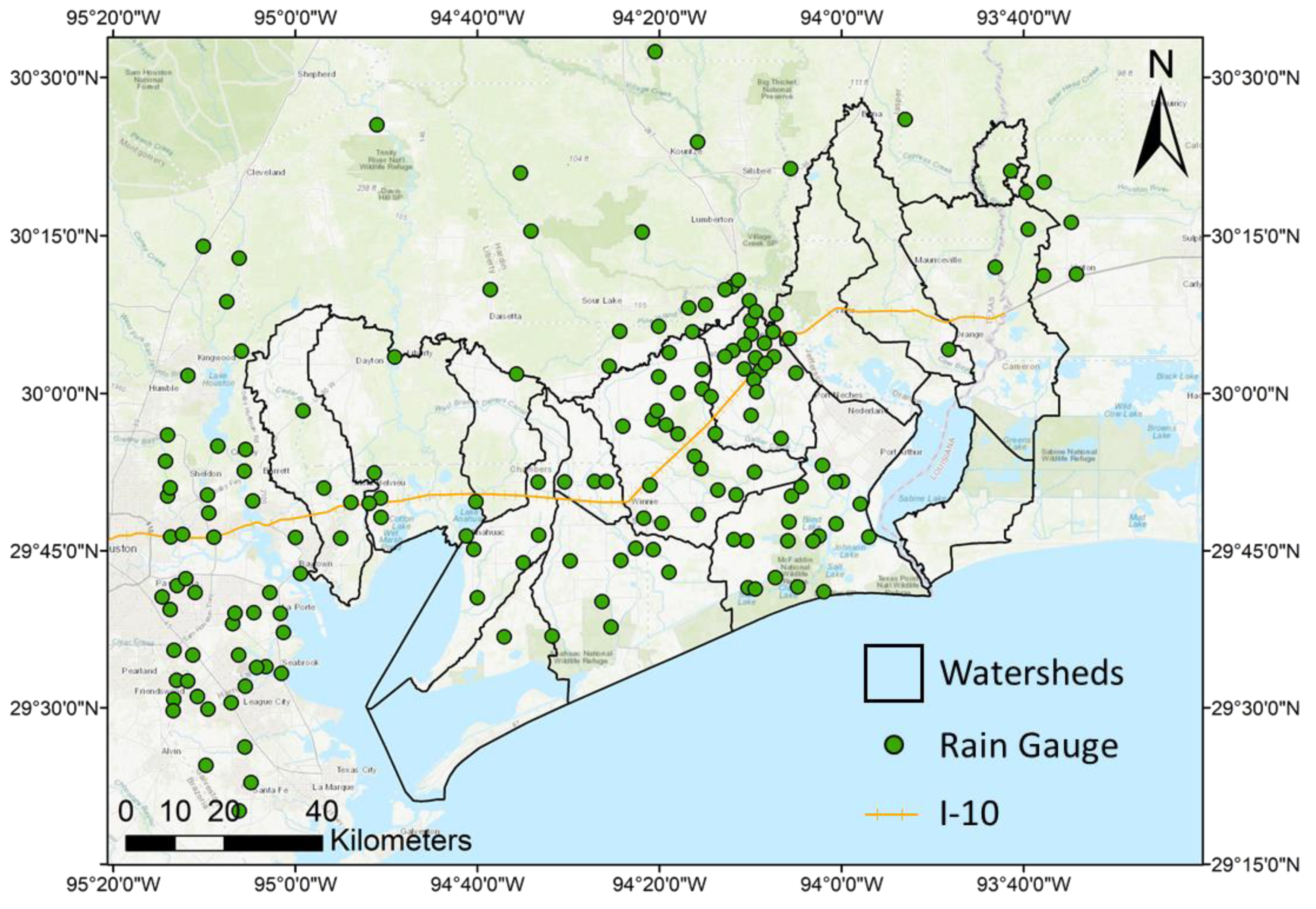
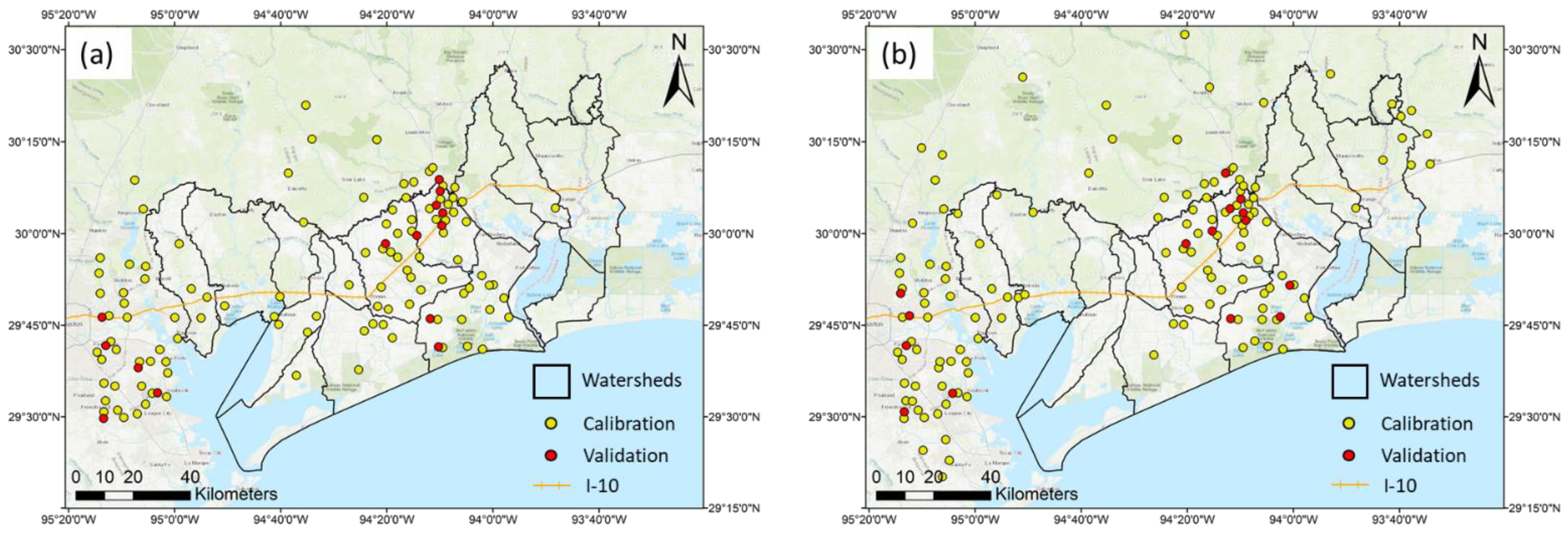
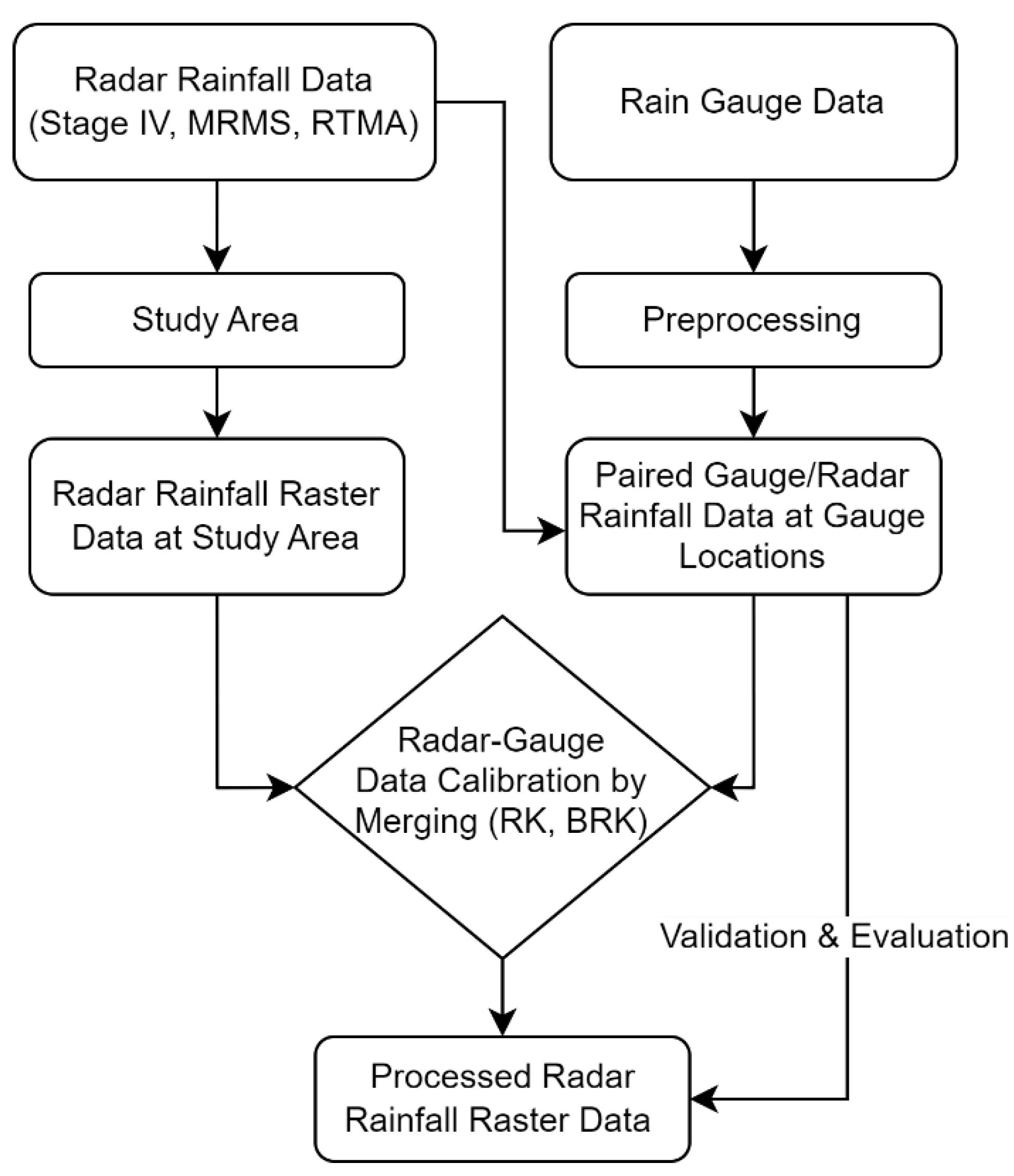

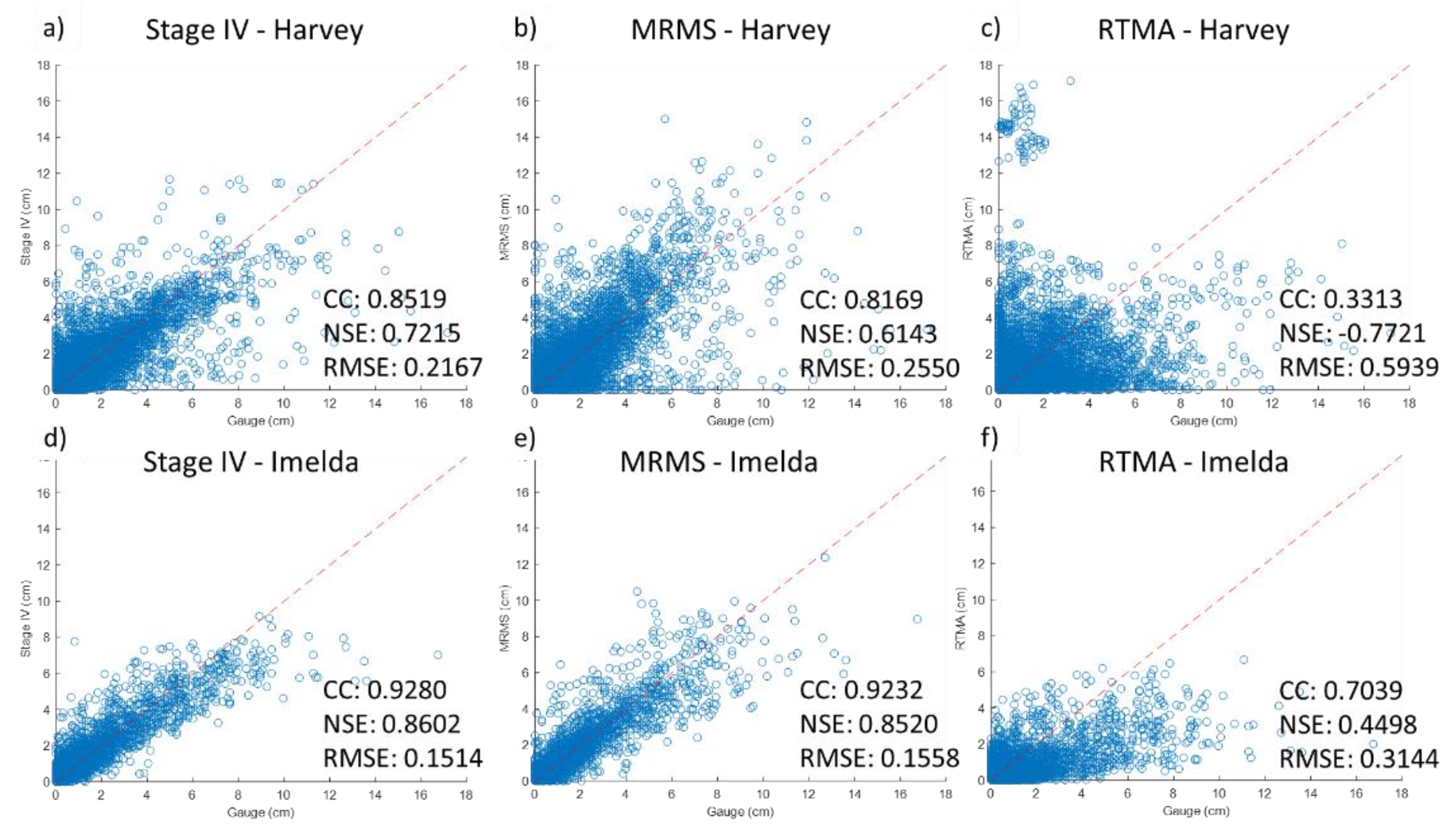
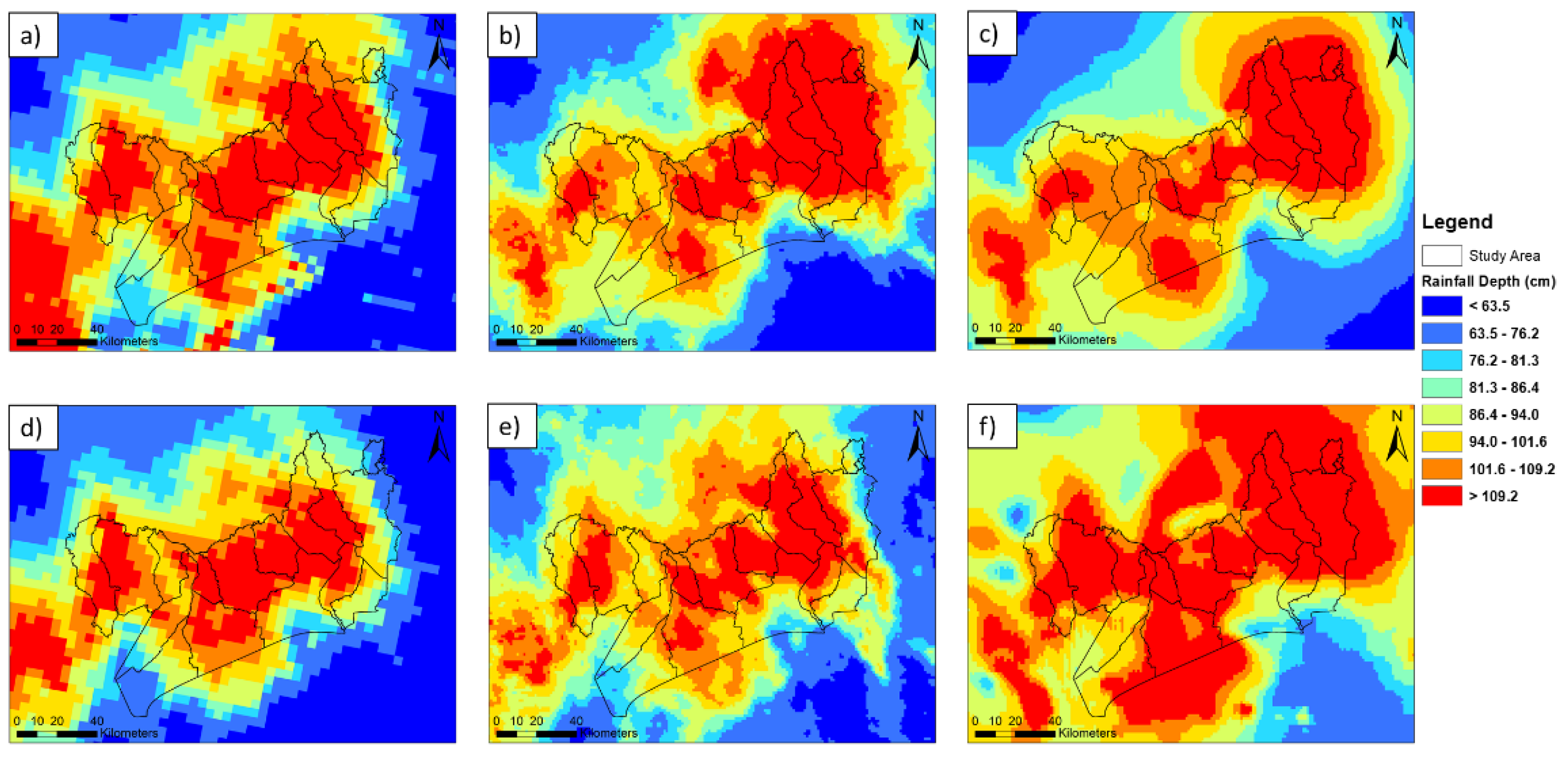

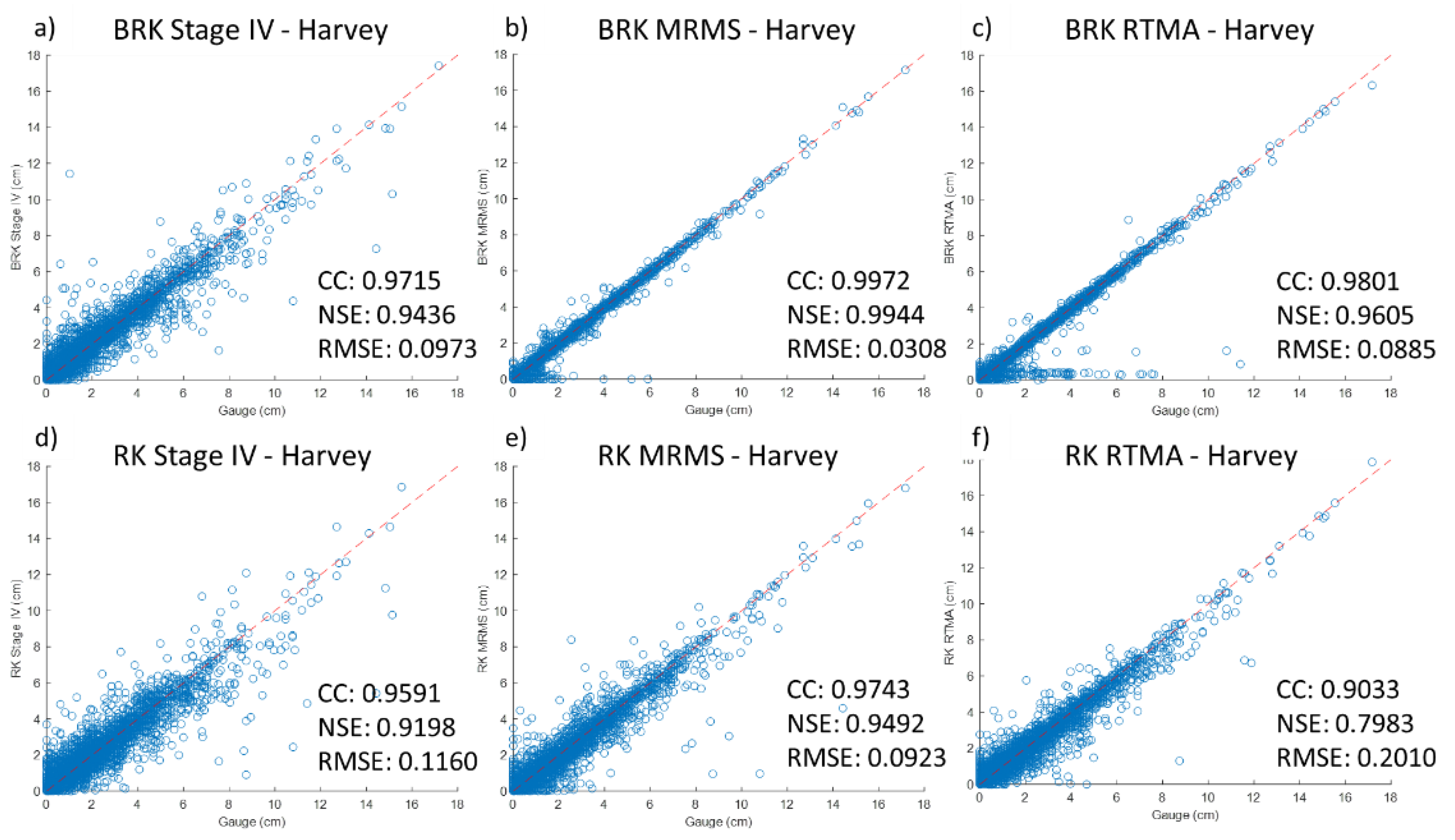
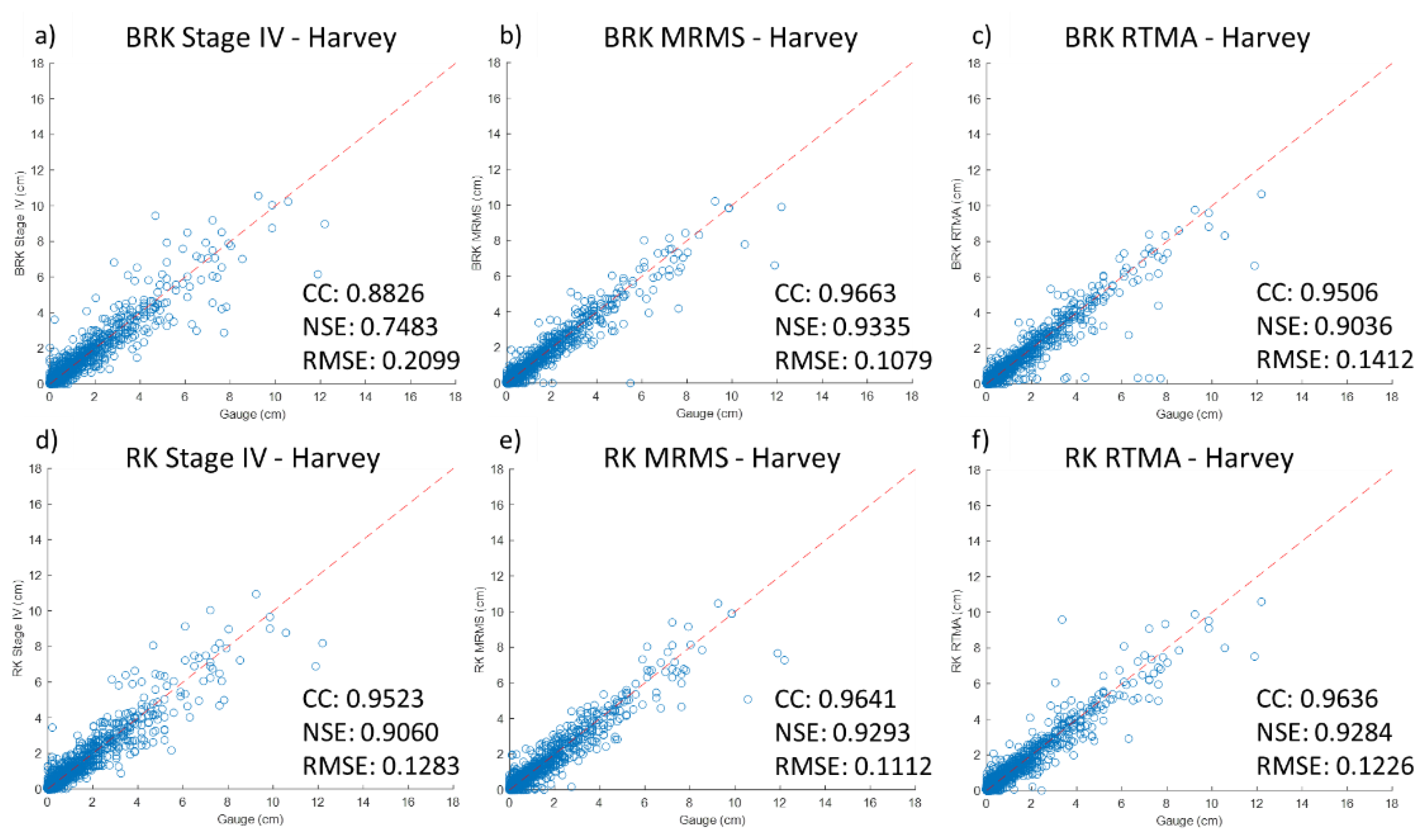
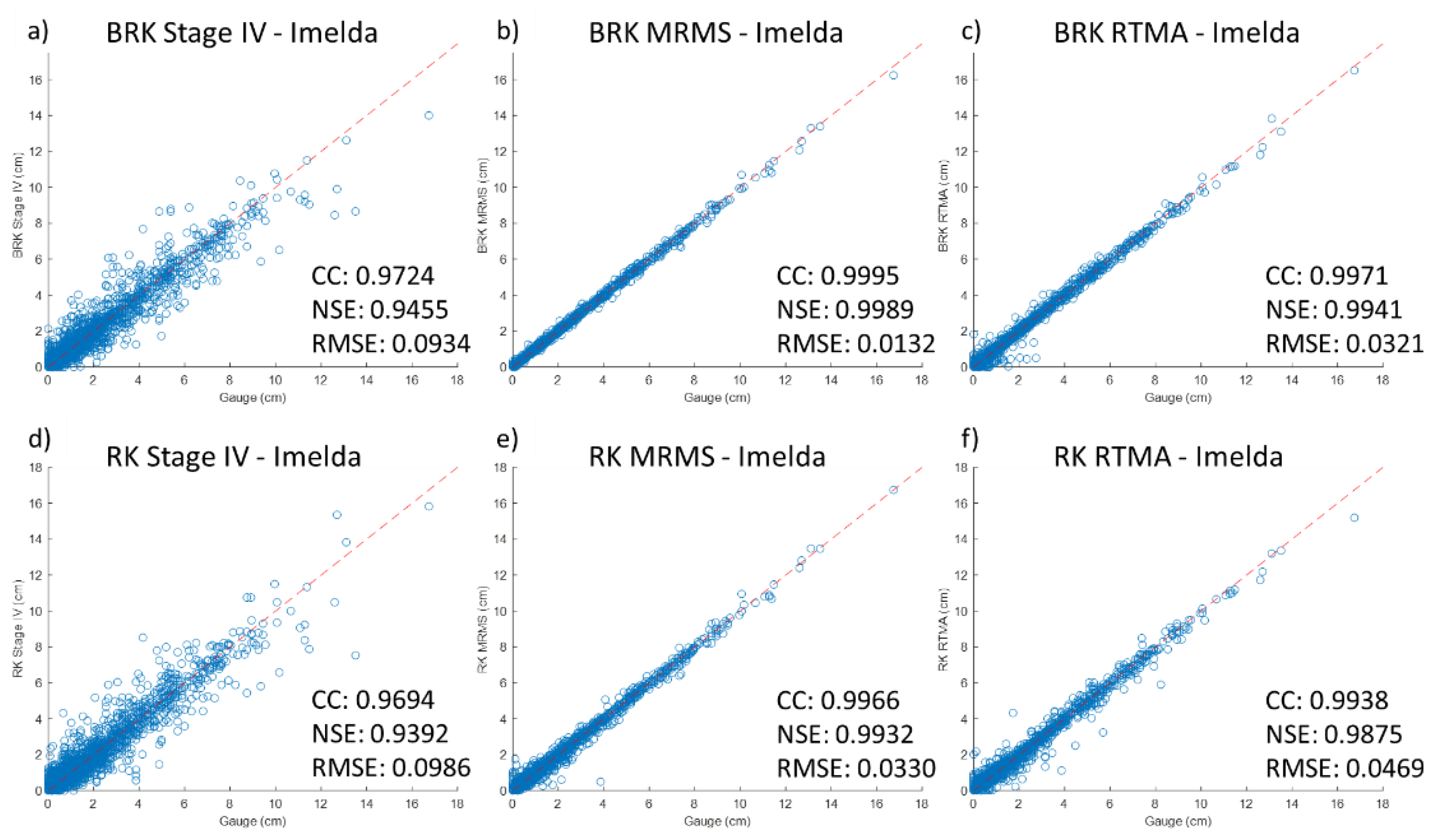
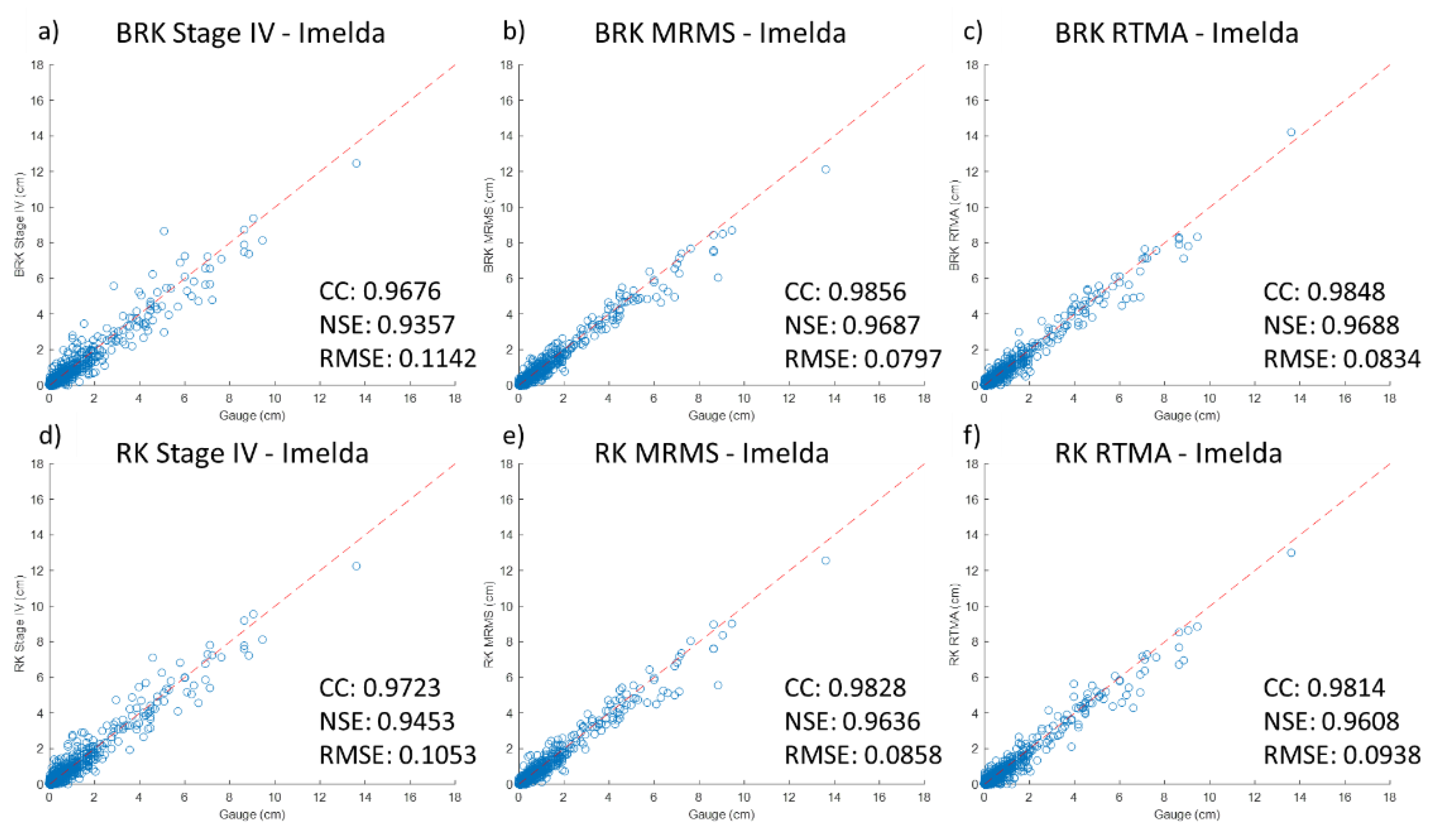
| Storms | Duration | Average Total Depth | Total | Calibration | Validation |
|---|---|---|---|---|---|
| 2017 Harvey | 8/23 to 9/3 (12 days) | 103.53 cm | 126 | 112 | 14 |
| 2019 Imelda | 9/17 to 9/22 (5 days) | 42.29 cm | 150 | 135 | 15 |
Disclaimer/Publisher’s Note: The statements, opinions and data contained in all publications are solely those of the individual author(s) and contributor(s) and not of MDPI and/or the editor(s). MDPI and/or the editor(s) disclaim responsibility for any injury to people or property resulting from any ideas, methods, instructions or products referred to in the content. |
© 2023 by the authors. Licensee MDPI, Basel, Switzerland. This article is an open access article distributed under the terms and conditions of the Creative Commons Attribution (CC BY) license (https://creativecommons.org/licenses/by/4.0/).
Share and Cite
Li, W.; Jiang, H.; Li, D.; Bedient, P.B.; Fang, Z.N. Evaluation of Radar Precipitation Products and Assessment of the Gauge-Radar Merging Methods in Southeast Texas for Extreme Precipitation Events. Remote Sens. 2023, 15, 2033. https://doi.org/10.3390/rs15082033
Li W, Jiang H, Li D, Bedient PB, Fang ZN. Evaluation of Radar Precipitation Products and Assessment of the Gauge-Radar Merging Methods in Southeast Texas for Extreme Precipitation Events. Remote Sensing. 2023; 15(8):2033. https://doi.org/10.3390/rs15082033
Chicago/Turabian StyleLi, Wenzhao, Han Jiang, Dongfeng Li, Philip B. Bedient, and Zheng N. Fang. 2023. "Evaluation of Radar Precipitation Products and Assessment of the Gauge-Radar Merging Methods in Southeast Texas for Extreme Precipitation Events" Remote Sensing 15, no. 8: 2033. https://doi.org/10.3390/rs15082033
APA StyleLi, W., Jiang, H., Li, D., Bedient, P. B., & Fang, Z. N. (2023). Evaluation of Radar Precipitation Products and Assessment of the Gauge-Radar Merging Methods in Southeast Texas for Extreme Precipitation Events. Remote Sensing, 15(8), 2033. https://doi.org/10.3390/rs15082033








